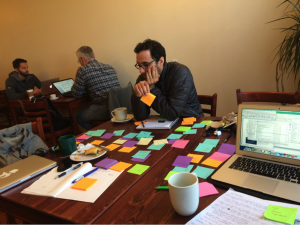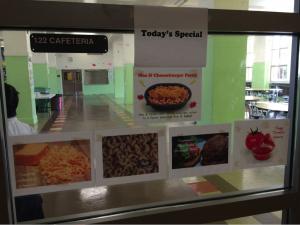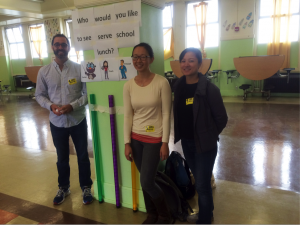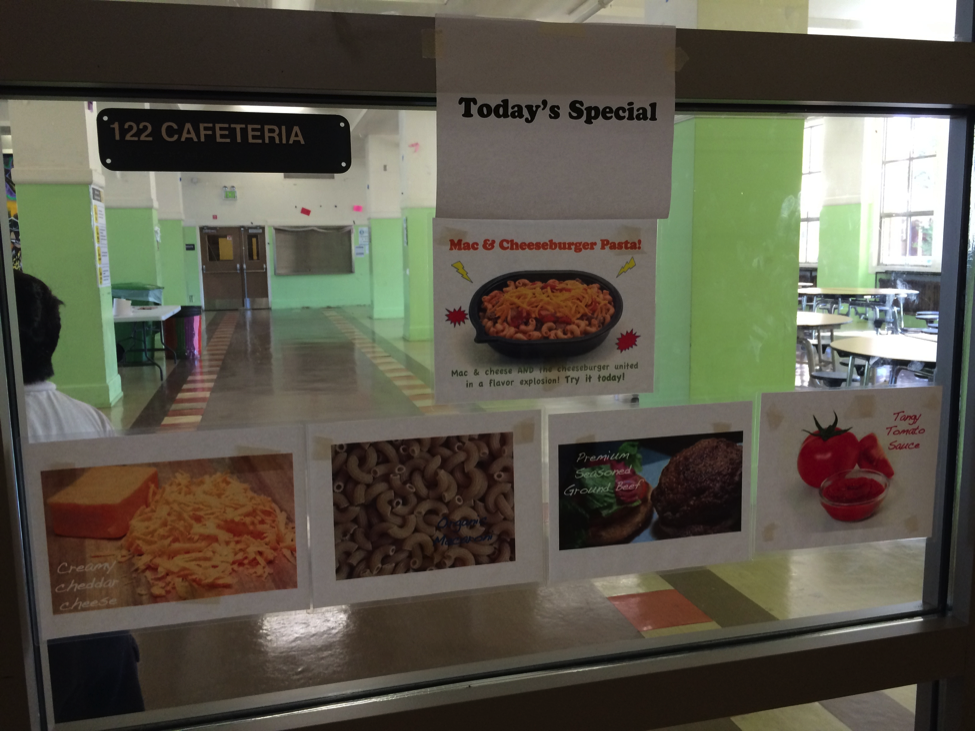Cheryl Young, Eric Fischer, and Stephanie Liu worked for client San Francisco Unified School District to address participation in school lunch programs. They focused on the social aspects of lunch in the hopes of making it cool and fun to eat at school.
Why aren’t students eating in San Francisco? A study conducted by YouthVote in 2011 found that one in five middle and high school students in San Francisco Unified School District (SFUSD) reported not eating lunch on most school days. Rates differed drastically in schools across the city, and they found schools with higher rates of students not eating lunch often had lower test scores. As a potential revenue stream for SFUSD, their food services operation was continually coming up short.
 SFUSD began to address lunch challenges when they switched to Revolution Foods in 2012, choosing fresh and healthier options prepared in Oakland. Through a donation from the Sara & Evan Williams Foundation, they hired the design firm IDEO to tackle the questions beyond food. IDEO developed student-centered dining experiences for different age groups, focused on cafeteria space and service redesign to make the lunch experience more convenient and engaging for students.
SFUSD began to address lunch challenges when they switched to Revolution Foods in 2012, choosing fresh and healthier options prepared in Oakland. Through a donation from the Sara & Evan Williams Foundation, they hired the design firm IDEO to tackle the questions beyond food. IDEO developed student-centered dining experiences for different age groups, focused on cafeteria space and service redesign to make the lunch experience more convenient and engaging for students.
As SFUSD moved forward implementing IDEO’s recommendations, lunch participation did not increase as much as expected. Our team conducted ethnography to learn about student, faculty, and lunch perspectives on school lunch at two middle schools. We learned about challenges that were not being addressed and our focus shifted toward internal factors where we could feasibly make a difference. We began exploring themes of student engagement, defining social norms, and adding elements of fun. How might we address unmet expectations, social stigma, and competing priorities?
Our student journey map laid out various points throughout the day where students made conscious or subconscious decisions about lunch. Do I know what’s for lunch? What are my friends doing? How long is the food line? Do I have time to eat and play? Does the food taste authentic? We chose specific points to address where we could develop quick, inexpensive, and fun prototypes.
where students made conscious or subconscious decisions about lunch. Do I know what’s for lunch? What are my friends doing? How long is the food line? Do I have time to eat and play? Does the food taste authentic? We chose specific points to address where we could develop quick, inexpensive, and fun prototypes.
We developed menu storyboards in an effort to highlight the premium ingredients of the day’s featured entrée. Elevating them beyond the plastic food container, we hoped to increase taste expectations, and normalize school lunch for everyone. As a result, students noticed the bright pictures, reacted amongst each other, and the cafeteria sold out of the Mac and Cheeseburger Pasta that day!
Our second prototype was a polling system to choose a special guest lunch server. Students who bought school lunch received a ball to vote for their favorite teacher, coach or principal. The goal was to create a fun incentive to bring students back into the cafeteria where they could co-produce their lunch experience. On the day we tested the game, the principal won the sixth and seventh grade votes, while eighth graders favored the coach.
 Having met with a group of teachers who are taking initiative to use design thinking to face school challenges, we are excited about the idea of developing a lunch curriculum. Additional structure to the lunch period and small innovations focused on student engagement can increase lunch consumption. As each school faces very different challenges, a one-size fits all solution may not exist. It will be critical for each school to take ownership and lead their lunch programming to tackle the multi-faceted challenge. Multi-disciplinary teams and collaborations will be important as we shape a new lunch culture for current and future generations of students.
Having met with a group of teachers who are taking initiative to use design thinking to face school challenges, we are excited about the idea of developing a lunch curriculum. Additional structure to the lunch period and small innovations focused on student engagement can increase lunch consumption. As each school faces very different challenges, a one-size fits all solution may not exist. It will be critical for each school to take ownership and lead their lunch programming to tackle the multi-faceted challenge. Multi-disciplinary teams and collaborations will be important as we shape a new lunch culture for current and future generations of students.

